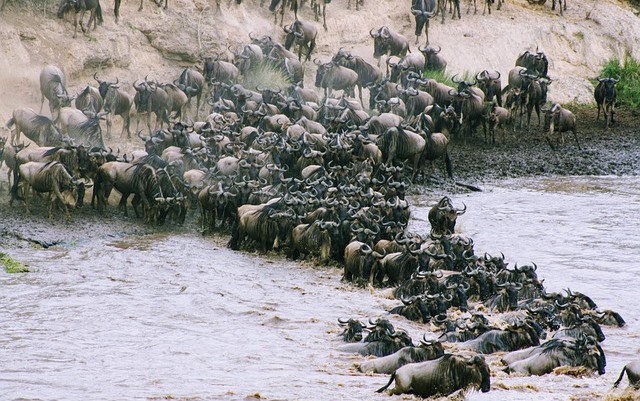Great Migration in Tanzania 2025/2026 – When, Where & How to See It
The Great Migration is one of nature's most extraordinary events—an annual spectacle that attracts wildlife lovers, photographers, and adventure seekers from around the globe. In 2025/2026, the migration will continue to unfold in the Serengeti-Mara ecosystem, a vast region stretching across Tanzania and Kenya. This incredible journey involves over a million wildebeest, zebras, and gazelles, moving in a continuous circle in search of food and water, driven by the changing seasons.
But when is the best time to witness this awe-inspiring event in Tanzania? And where should you go to see it? In this guide, we’ll explore the best times, locations, and expert tips on how to make the most of your Tanzania safari to witness the Great Migration in 2025/2026. Book your Migration safari in Tanzania 2025/2026 - EMAIL: This email address is being protected from spambots. You need JavaScript enabled to view it. OR Call/WhatsApp +254 728 567 308
When to See the Great Migration in Tanzania
Understanding the timing of the Great Migration is key to planning the perfect safari. The migration follows a year-long route across Tanzania’s Serengeti National Park and Kenya’s Masai Mara. Here’s a breakdown of the migration’s timing, month by month:
January to March – Calving Season in Southern Serengeti
Location: Southern Serengeti and Ndutu Region
The calving season occurs from January to March when the herds of wildebeest, zebras, and gazelles give birth to approximately 500,000 calves. This period is one of the best times to witness predator-prey interactions as lions, cheetahs, and hyenas hunt the newborns. The herds are concentrated in the nutrient-rich plains of Ndutu, making this a prime time for seeing young animals and predators in action.
Highlight: The predator-prey interactions and witnessing newborn calves is a photographer’s dream.
April to June – Movement Towards the Western Corridor
Location: Western Serengeti and Grumeti Reserve
As the plains of Southern Serengeti begin to dry out, the herds start migrating northward toward the Western Serengeti and Grumeti River. The migration faces its first major river crossing at the Grumeti River, where crocodiles wait for the animals to cross. While not as famous as the Mara River crossings, this is still a dramatic and perilous stage of the migration.
Highlight: The Grumeti River crossing with crocodiles is a thrilling, lesser-known part of the migration.
July to October – Mara River Crossings in Northern Serengeti
Location: Northern Serengeti and Masai Mara
From July to October, the herds reach the Northern Serengeti, preparing for the Mara River crossing. This is the most dramatic phase of the migration, with the wildebeest facing strong river currents, predators on the banks, and treacherous crossings. The spectacle of thousands of wildebeest, zebras, and gazelles crossing the river, often pursued by crocodiles and big cats, makes this one of nature’s most powerful displays.
Highlight: The Mara River crossing is the iconic moment of the Great Migration, with dramatic action and life-or-death moments.
November to December – Return to Southern Serengeti
Location: Southern Serengeti and Ndutu
After the short rains in November, the herds begin their return journey southward to the Southern Serengeti, completing the full circle of their migration. This is a quieter time to witness the migration, but still offers excellent wildlife sightings as the herds prepare for another calving season.
Highlight: The calving season resumes in January, as the cycle begins again, bringing new life to the plains.
Where to See the Great Migration in Tanzania
Different stages of the migration are best witnessed in specific regions of Tanzania. The key areas to visit include:
Ndutu Plains & Southern Serengeti (Calving)
For those seeking to witness the calving season (January–March), the Ndutu Plains in the Southern Serengeti is the place to be. This region is known for its lush grasslands, perfect for the herds to graze and give birth. The presence of predators like lions, cheetahs, and hyenas makes this area incredibly exciting for wildlife watchers.
Best Time: January–March
Wildlife Highlight: Newborn calves and predator interactions.
Grumeti River & Western Serengeti (River Crossings)
As the migration moves west, the Grumeti River is another prime location to see dramatic river crossings, particularly in June–July. The Grumeti Reserve offers a more exclusive safari experience compared to other parts of the Serengeti, and you can witness the herds crossing the river while dodging crocodiles.
Best Time: June–July
Wildlife Highlight: Crocodile-infested river crossings.
Mara River & Northern Serengeti (Mara River Crossings)
The Mara River, which forms the border between Tanzania and Kenya, is the location for the most iconic event of the Great Migration. The Northern Serengeti offers prime views of the wildebeest as they cross the river, often during the peak of the migration from July to October.
Best Time: July–October
Wildlife Highlight: The dramatic Mara River crossings and predator sightings.
How to See the Great Migration
Best Safari Packages for the Migration
Many tour operators offer safari packages tailored to the migration. These packages vary depending on your preferred travel dates, budget, and interests. From budget camping safaris to luxury lodge stays, there’s an option for every type of traveler.
Tip: Private safaris or small group tours allow for a more personalized experience and a better chance of securing prime viewing spots during river crossings.
Fly-in vs. Drive-in Safaris
For convenience, fly-in safaris are a great option for reaching remote areas like the Northern Serengeti or Mara River. These offer quicker access and less time spent in transit. Alternatively, drive-in safaris give a more immersive experience, allowing you to see a variety of landscapes and wildlife.
Tip: Fly-in safaris are often more expensive but save time, especially if you're short on time.
Mobile Camps vs. Permanent Lodges
Staying in a mobile tented camp places you close to the migration, allowing for a truly immersive experience. Permanent lodges offer more luxury and comfort but may be farther from the migration’s prime viewing areas.
Hot Air Balloon Safaris for Aerial Views
For a unique perspective, consider a hot air balloon safari over the Serengeti. The aerial view of the migration is breathtaking, and it allows you to see the herds from a completely different angle.
Tip: Book your balloon ride well in advance, as spots fill up quickly, especially during peak migration months.
Tips for Planning Your Migration Safari
When to Book & How Far in Advance
Booking your safari 6–12 months in advance is crucial for securing accommodations during the peak migration period, especially in popular locations like the Mara River and Northern Serengeti.
Choosing the Right Region for Your Dates
Make sure to choose a region based on the timing of the migration. If you're aiming for Mara River crossings, plan your visit between July and October. For calving season, the Southern Serengeti in January–March is ideal.
Budget vs. Luxury Migration Safari Options
Safari prices vary depending on your accommodation choice. Budget safaris focus on camping and basic lodges, while luxury safaris provide high-end accommodations and personalized service, including private guides and exclusive campsites.
Travel Insurance & Health Essentials
Ensure you have comprehensive travel insurance that covers emergency medical expenses, trip cancellations, and unexpected delays. Vaccinations may be required, so consult with a healthcare professional before you travel.
Frequently Asked Questions (FAQ) About the Great Migration
Q: How long does the Great Migration last?
A: The migration lasts year-round, but the key events—such as calving season and river crossings—occur at specific times of the year. The full cycle lasts 12 months, and the herds return to the Southern Serengeti for calving every January.
Q: Can you see the migration year-round in Tanzania?
A: While the Great Migration is a year-round phenomenon, witnessing the iconic moments such as the Mara River crossing or calving requires careful timing. Peak viewing occurs from July to October.
Q: Is it better to see the migration in Tanzania or Kenya?
A: Both Tanzania and Kenya offer unique experiences of the Great Migration, but Tanzania’s Serengeti is often considered the heart of the migration. Kenya’s Masai Mara provides dramatic river crossings, especially in August–October.
Witnessing the Great Migration in Tanzania is an experience of a lifetime. By planning ahead, choosing the right time and location, and working with an experienced safari operator, you can immerse yourself in this remarkable journey and create memories that will last forever






